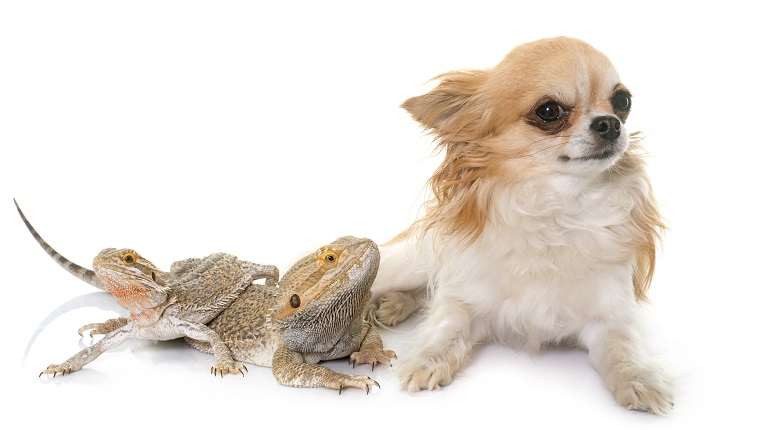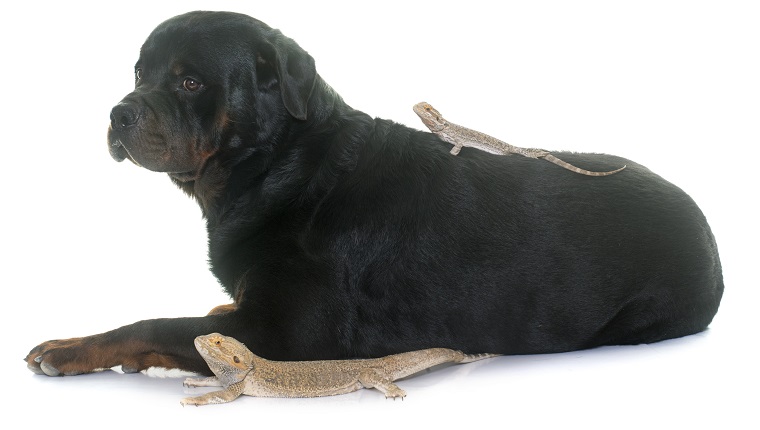There’s no doubt about it; dogs are humans’ best friends. Our dogs cherish every second with us, love us for who we are, and always trust us as their pet parents.
But, can a dog be best friends with a bearded dragon too?
Fortunately, if you’re planning to introduce your dog to a bearded dragon, there are practical steps you can take to promote a lasting friendship while keeping both animals safe. Here are a few tips!
1. Start In A Quieter Area Of The House
When introducing a dog to any new pet, it’s a good idea to do it away from the home so both animals can be in neutral territory. However, this can be difficult with reptiles.
Your dog is used to having the house to themselves, so introducing them in a neutral part of the house is a better idea. This will prevent territorial or protective behavior from your dog.
A quiet space or your study room are great places to do this! Avoid using areas where your dog spends most of their time in your house.
2. Get A Helper

Introducing your pets will take two people. Both your dog and your bearded dragon will need to be controlled at all times during their first interactions in these ways.
Ideally, rely on another family member to control your dog. It’s best to keep your dog on a loose leash. If your pup reacts negatively, it is important to have them on a leash so they don’t hurt your bearded dragon.
However, the leash should be loose enough that your dog can move around without feeling restricted because restriction can make the experience stressful.
You should hold your bearded dragon with a flat palm to make them feel safe.
3. Avoid Over-Stimulation
Sudden movements, loud noises, or unfamiliar faces can all create stress for your pets during their first meeting.
Becoming comfortable with each other is exciting enough for your pets, so any additional stimulation could arouse aggressive or fearful behavior. To avoid excitement or over-stimulation:
- Do not invite visitors to your home while your pets are interacting.
- If you’re first introducing your pets in a park, make sure there aren’t too many other families or dogs present.
- If you’re going to let your children play with the animals together, always supervise the interaction carefully.
4. Don’t Leave Your Pets Unattended

If left alone together, both animals are at risk, but your bearded dragon is more vulnerable.
Dogs are usually a lot bigger than lizards, so any rough play can hurt your bearded dragon. So, their first interactions with each other should be well-controlled and closely monitored at all times.
Once they’ve already interacted positively many times, you can leave them alone together for a short period to see how they do, but don’t go too far. If they do act in unexpected negative ways, you must be ready to respond quickly.
5. Look For Body Language
If your dog is becoming stressed or hostile, they may exhibit these signs:
- Long, unwavering stares
- A lifted lip or growling
- Stiff muscles and posture
- Blocking your bearded dragon from getting close to you or another family member
If your dog is calm, they may wag their tail, sniff around, and maintain a loose, wiggly posture.
Bearded dragons are usually quite docile and friendly. However, if they’re feeling threatened by your dog, they may extend their “beard” to appear bigger or try hiding.
Aggression is typically only directed towards other bearded dragons, but here are the signs:
- Long, unwavering stares
- Chasing
- Circumduction, in which they bob their heads and turn their legs in circles
If your dog becomes aggressive or stressed, you need to redirect them to another activity. A good way to distract your dog is to bring out one of their favorite toys or simply call them over to a different area.
Once they’ve calmed down, you can allow them to interact with your bearded dragon again, but watch them very carefully.
If you see an aggressive behavior from your dog, the worst thing you can do is punish them. Punishment will lead to fear, aversion, and increased conflict in the long run.
It can be hard for your dog to respond to new pet appropriately, and it may take some time before they get along. Be patient with your dog, and allow them to learn good behavior without punishment.
Have you ever introduced your dog to a new pet? Has your pup ever met a bearded dragon? Let us know in the comments below!
Click the bold links in the article to shop and support our content!








